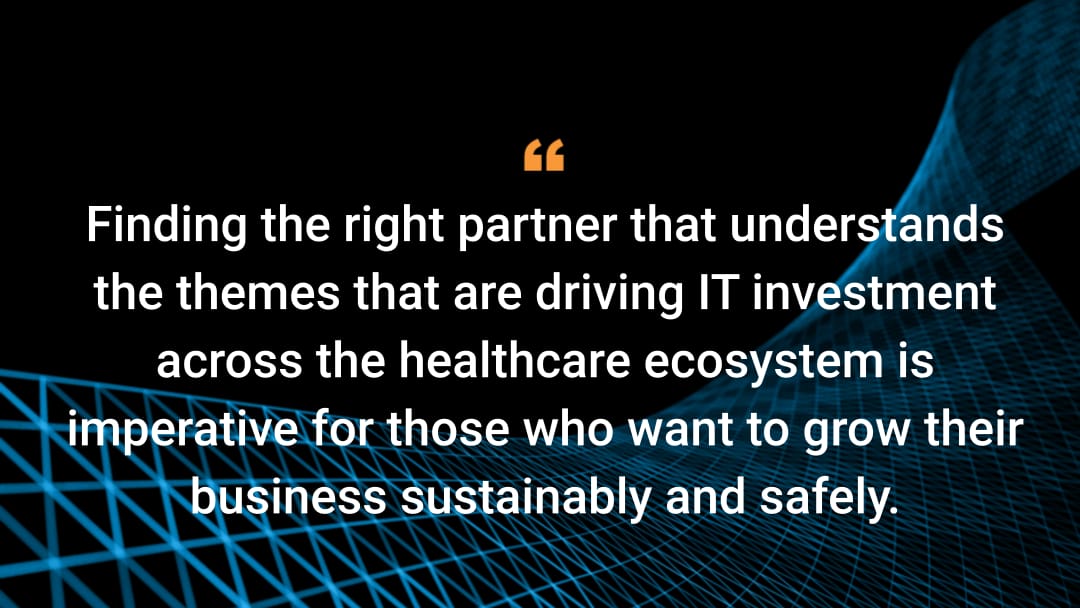Today’s Top 4 IT Investment Trends Across the Healthcare Ecosystem

No matter where provider, payer, healthcare information technology (HCIT), or life sciences organizations sit in the healthcare ecosystem, they have shared goals: providing excellent patient care, enhancing clinical and financial results, and increasing efficiency among them.
They also have myriad shared challenges.
From virtual care to interoperability, digital transformation in healthcare is at long last progressing. Data shows that 95% of providers plan to make significant investments in technology in 2023, with 70% of pharmaceutical companies saying that cybersecurity threats will have the greatest impact on their company this year.
But, by and large, organizations’ cybersecurity postures have not kept up with the pace of change and the increasing sophistication of threat actors.
Finding the right partner that understands the themes that are driving IT investment across the healthcare ecosystem is imperative for those who want to grow their business sustainably and safely.
Here are the top four IT investment trends shared across healthcare and life sciences.
1. Interoperability and data sharing
Healthcare data sharing includes a multitude of financial, clinical, and operational benefits. Those include reduced friction across the continuum (especially between providers and payers), resulting in improved coverage decisions and cost reductions with enhanced access to patient records; reduced redundant testing; and increased data-driven decisions across broad populations and geographies.
Interoperability — the integration of electronic health data so that it can be used to optimize health outcomes for individuals and populations — is one of the most crucial components supporting this exchange of information.
Since data is shared — often facilitated by APIs — among providers, payers, employers, patients, and other third parties, like electronic health records, vendors, and health information exchanges, there's a crucial need to secure digital interactions.
Learn how Akamai can secure your healthcare or life sciences’ organizations apps and APIs. For more information, reference our IT investment white papers for providers, payers, or HCIT.
2. Virtual care
Virtual care is much more comprehensive than “simple” provider evaluations of a patient. On-camera modalities accelerated rapidly during the pandemic and, today, tools like remote patient monitoring devices enable clinical care delivery outside of traditional brick-and-mortar care settings.
In pharmaceuticals and life sciences, virtual care includes decentralized clinical trials that are designed to be executed wherever the patients are physically located, broadening the pool of potential participants in clinical trials.
Virtual care enables real-time communication and data collection from patients, often reduces time to action, empowers patients to take control of their healthcare journey, and increases potential medication efficacy.
Expanding the use of communication modalities and devices increases the breadth of the Internet of Medical Things. Learn how Akamai can protect your ecosystem by referencing our IT investment white papers for providers or life sciences.
3. Cloud hosting and digital transformation
Cloud hosting offers opportunities to improve clinical and financial outcomes across the healthcare continuum.
For providers, cloud hosting enables data-heavy workloads, such as medical images and electronic health records, to be stored securely, without investing heavily in on-premises infrastructure. In life sciences, cloud computing can support precision medicine strategies by storing and analyzing complex genomic data and help derive personalized care strategies.
Cloud-hosted deployments in HCIT yield recurring, long-term, and predictable revenue streams. And for payers, the cloud enhances scalability and improves the cost, quality, and convenience of member services.
There’s no going back when it comes to the cloudification of healthcare and life sciences. Learn more about partnering with Akamai for strategic IT spend as a payer, provider, HCIT, or life sciences.
4. Consolidations, and mergers and acquisitions
The volume of mergers between payers and providers — often called “payviders” — continues to increase at a rapid pace, but is by no means the end of such movement across the healthcare ecosystem.
Large provider groups continue to expand their health insurance plan offerings, while life sciences companies are realizing the benefits of mergers and acquisitions. These benefits include access to new markets and expanding portfolios, like the pipeline replenishment of drugs that are reaching patent cliffs and veering toward profitability decline.
Consolidation and inorganic growth are some of the main drivers fueling HCIT investment. Such movements help achieve economies of scale, while meeting buyers’ desire for vendor consolidation by offering a more robust product suite.
Akamai’s breadth of offerings for life sciences, HCIT, and beyond can secure your infrastructure and organization as you grow and innovate — whether or not that includes a merger or consolidation.
Learn more
Looking for more details on how Akamai can be a strategic partner for healthcare and life sciences organizations? Visit our website.



